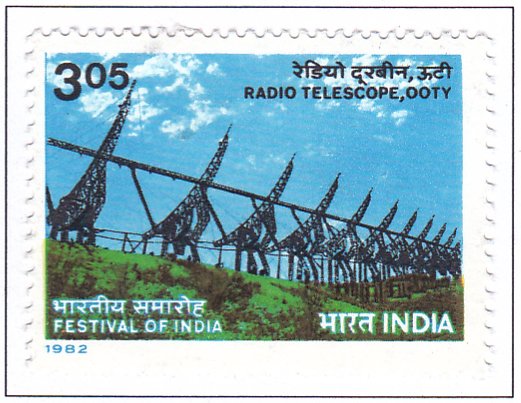Festival of India – Science and Technology

Technical Data
| Date of Issue | March 24, 1982 |
|---|---|
| Denomination | Rs. 3.05 |
| Quantity | 2,000,000 |
| Perforation | comb 13½ x 13 |
| Printer | Security Printing Press, Nashik |
| Watermark | No Watermark |
| Colors | Multicolor |
| Catalog Codes |
Michel IN 905 Stamp Number IN 956 Yvert et Tellier IN 706 Stanley Gibbons IN 1040 |
| Themes | Astronomy | Radio | Telecommunication | Telescopes |
The Science and Technology Radio Telescope in Ooty is a monumental achievement in the field of astronomy and radio astronomy. This colossal radio telescope, shaped like a parabolic cylinder measuring 530 meters in length and 30 meters in width, operates at 327 MHz and ranks among the largest telescopes in the world operating at meter wavelengths. Its sensitivity surpasses even the renowned 76-meter diameter Jodrell Bank parabolic dish by four times.
The reflecting surface of the telescope consists of 1100 thin stainless steel wires supported on 24 steel frames mounted on equidistant steel towers. Its beam can be steered mechanically in the East-West direction and electronically in the North-South direction. With its axis aligned parallel to the Earth’s axis of rotation, the telescope utilizes an appropriate hill slope for optimal performance.
Operated by the Tata Institute of Fundamental Research under the Department of Atomic Energy of the Government of India, this indigenous marvel has spearheaded groundbreaking scientific research programs and yielded significant results.
One of its key applications is the study of radio sources in the sky through Lunar occultation techniques, providing crucial insights into the physics of radio sources and supporting the Big Bang model. Additionally, it facilitates interplanetary scintillation observations, aiding cosmological investigations and serving as an early warning system for geomagnetic disturbances.
The telescope has also played a pivotal role in the discovery of pulsars and other astronomical phenomena, contributing to our understanding of the universe. Its future development includes the construction of a synthesis radio telescope, extending its capabilities for high-resolution studies of radio sources.
The technological advancements stemming from the Ooty Radio Telescope Project have not only bolstered India’s self-reliance in designing and fabricating large microwave antennae but have also led to innovative applications in other domains, such as solar energy concentrators.
The Indian Posts and Telegraphs Department takes pride in commemorating the remarkable achievements in Science and Technology exemplified by the Ooty Radio Telescope through the issuance of a commemorative stamp.
(Text adapted from material courtesy of the Department of Science and Technology).
